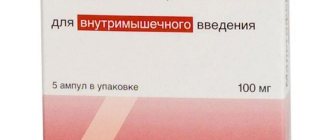Meloflex Rompharm, 10 mg/ml, solution for intramuscular administration, 1.5 ml, 5 pcs.
Patients suffering from diseases of the gastrointestinal tract should be monitored regularly. If ulcerative lesions of the gastrointestinal tract or gastrointestinal bleeding occur, the drug must be discontinued.
Gastrointestinal ulcers, perforation, or bleeding may occur at any time during the use of NSAIDs, with or without warning symptoms or a history of serious gastrointestinal complications. The consequences of these complications are generally more serious in older people.
When using the drug, serious skin reactions such as exfoliative dermatitis, Stevens-Johnson syndrome, toxic epidermal necrolysis may develop.
Therefore, special attention should be paid to patients reporting the development of adverse events from the skin and mucous membranes, as well as hypersensitivity reactions to the drug, especially if such reactions were observed during previous courses of treatment. The development of such reactions is observed, as a rule, during the first month of treatment. If the first signs of skin rash, changes in mucous membranes or other signs of hypersensitivity appear, discontinuation of the drug should be considered.
Cases have been described when taking NSAIDs to increase the risk of developing serious cardiovascular thrombosis, myocardial infarction, angina, possibly fatal. This risk increases with long-term use of the drug, as well as in patients with a history of the above diseases and predisposed to such diseases.
NSAIDs inhibit the synthesis of prostaglandins in the kidneys, which are involved in maintaining renal perfusion. The use of NSAIDs in patients with reduced renal blood flow or reduced circulating blood volume may lead to decompensation of latent renal failure. After discontinuation of NSAIDs, renal function usually returns to baseline levels. Those most at risk for developing this reaction are elderly patients who have dehydration, chronic heart failure, liver cirrhosis, nephrotic syndrome or acute renal impairment, patients concomitantly taking diuretics, ACE inhibitors, angiotensin II receptor antagonists, and patients those who have undergone major surgical interventions that lead to hypovolemia. In such patients, diuresis and renal function should be carefully monitored when initiating therapy.
The use of NSAIDs in combination with diuretics can lead to sodium, potassium and water retention, as well as a decrease in the natriuretic effect of diuretics. As a result, predisposed patients may experience increased signs of heart failure or hypertension. Therefore, such patients should be closely monitored and adequate hydration maintained. Before starting treatment, a kidney function test is necessary. In case of combination therapy, renal function should also be monitored.
When using the drug Meloflex Rompharm (as well as most other NSAIDs), an episodic increase in the activity of “liver” transaminases in the blood serum or other indicators of liver function is possible. In most cases, this increase was small and transitory. If the detected changes are significant or do not decrease over time, the drug should be discontinued and the detected laboratory changes should be monitored.
Weakened or malnourished patients may be less able to tolerate adverse events and should therefore be monitored closely.
Like other NSAIDs, Meloflex Rompharm can mask the symptoms of an underlying infectious disease.
As a drug that inhibits cyclooxygenase/prostaglandin synthesis, Meloflex Rompharm may affect fertility and is therefore not recommended for women who have difficulty conceiving. In this regard, in women undergoing examination for this reason, it is recommended to discontinue taking the drug Meloflex Rompharm.
In patients with mild or moderate renal failure (creatinine clearance more than 25 ml/min), no dose adjustment is required.
In patients with liver cirrhosis (compensated), no dose adjustment is required.
The influence of a medicinal product for medical use on the ability to drive vehicles and machinery
Special clinical studies of the effect of meloxicam on the ability to drive a car and operate machinery have not been conducted. However, when driving or operating machinery, the possibility of dizziness, drowsiness, visual impairment or other disorders of the central nervous system should be taken into account. During the treatment period, patients must be careful when driving vehicles and engaging in other potentially hazardous activities that require increased concentration and speed of psychomotor reactions.
Similar drugs:
- Serrata Oral tablets
- Ibufen Oral suspension
- Dollar () Oral tablets
- Ketanov Oral tablets
- Synmeton (SYNMETON) Oral tablets
- Novalgin Oral tablets
- Milistan Caplets
- Spasmalin Solution for injection
- Aspirin Oral tablets
- Incena Capsule
** The Drug Directory is intended for informational purposes only. For more complete information, please refer to the manufacturer's instructions. Do not self-medicate; Before starting to use Meloflex Rompharm, you should consult a doctor. EUROLAB is not responsible for the consequences caused by the use of information posted on the portal. Any information on the site does not replace medical advice and cannot serve as a guarantee of the positive effect of the drug.
Are you interested in the drug Meloflex Rompharm? Do you want to know more detailed information or do you need a doctor's examination? Or do you need an inspection? You can make an appointment with a doctor - the Euro lab is always at your service! The best doctors will examine you, advise you, provide the necessary assistance and make a diagnosis. You can also call a doctor at home . Euro lab clinic is open for you around the clock.
** Attention! The information presented in this medication guide is intended for medical professionals and should not be used as a basis for self-medication. The description of the drug Meloflex Rompharm is provided for informational purposes only and is not intended for prescribing treatment without the participation of a doctor. Patients need to consult a specialist!
If you are interested in any other drugs and medications, their descriptions and instructions for use, information about the composition and form of release, indications for use and side effects, methods of use, prices and reviews of drugs, or you have any other questions and suggestions - write to us, we will definitely try to help you.
Taking medication during lactation and pregnancy
Suppression of prostaglandin synthesis negatively affects the intrauterine development of the fetus. This is why the drug should not be used during pregnancy. If necessary, it can be replaced with other, safer means. But for this, a pregnant woman should definitely contact her doctor.
It should also be noted that the medication is excreted along with mother's milk, so you should stop breastfeeding the baby during its use.
Pharmacokinetics of the drug
After using the drug "Meloflex", reviews of which are ambiguous, its active component binds to plasma proteins in a volume of 99%. This medication passes through the histohematic barrier and also enters the synovial fluid. Moreover, the concentration in it is 50% of the concentration in plasma.
Metabolism of the drug occurs in the liver (metabolized to inactive metabolites). The drug is released through the intestines and through the kidneys (in equal parts). In this case, the drug is excreted unchanged in an amount of 5% of the daily dose.
Careful use of the product
In what cases is Meloflex prescribed with special caution? The instructions for use of the injection solution contain information that it should be prescribed with extreme caution to the elderly, as well as to patients with coronary artery disease, diabetes mellitus, cerebrovascular diseases, heart failure (chronic), dyslipidemia/hyperlipidemia, peripheral arterial disease, renal failure ( with CC 30-60 ml/min), a history of ulcerative lesions of the gastrointestinal tract, the presence of Helicobacter pylori infection and severe somatic abnormalities.
Also, this drug should be used with extreme caution by people who smoke and suffer from alcoholism. In addition, long-term use of this NSAID is prohibited, as well as its simultaneous use with oral corticosteroids, including Prednisolone, anticoagulants, including Warfarin, antiplatelet agents, including Clopidogrel, selective reuptake inhibitors serotonin, including the medications Citalopram, Fluoxetine, Paroxetine and Sertraline.
Indications for use of NSAIDs
For what deviations is Meloflex (injections) indicated? The instructions for use contain information that the presented medication is prescribed only in the following cases:
- for rheumatoid arthritis;
- for osteoarthritis;
- with ankylosing spondylitis (ankylosing spondylitis).
It should also be said that this type of medication is very often prescribed for symptomatic treatment, reduction of pain syndromes and inflammation that exist at the time of use of the drug. It should also be said that it does not affect the progression of the disease in any way. Therefore, it can be prescribed without any fear to patients with the above-mentioned diagnoses.
Contraindications
- a combination of bronchial asthma, recurrent polyposis of the nose and paranasal sinuses and intolerance to acetylsalicylic acid and pyrazolone drugs;
- peptic ulcer of the stomach and duodenum (in the acute phase);
- active gastrointestinal bleeding;
- chronic renal failure in patients not undergoing dialysis (creatinine clearance less than 30 ml/min);
- progressive kidney disease;
- severe liver failure or active liver disease;
- condition after coronary artery bypass surgery;
- confirmed hyperkalemia;
- inflammatory bowel diseases;
- children and adolescents up to 18 years of age;
- hypersensitivity to the components of the drug;
- hypersensitivity to other NSAIDs.
Pharmacological characteristics of the injection product
What is the drug "Meloflex" (injections)? The instructions for use of the injection solution state that it is an anti-inflammatory drug (non-steroidal). This medication is a derivative of enolic acid, due to which it is able to have antipyretic and analgesic effects.
The pronounced anti-inflammatory effect of the mentioned drug has been established in all models of (standard) inflammation. The principle of operation of the drug is that it is able to inhibit the synthesis of prostaglandins, which, in fact, are known mediators of inflammation.
It should be especially noted that the drug "Meloflex", the price of which is not very high, inhibits the synthesis of prostaglandins at the site of inflammation much more than in the kidneys or gastric mucosa. These differences are directly related to the more selective inhibition of cyclooxygenase-2 compared to cyclooxygenase-1. Experts say that due to the inhibition of COX-2, the therapeutic effect of the presented drug is ensured. However, inhibition of the persistent COX-1 isoenzyme is very often the cause of side effects from the kidneys and stomach.
Cases of overdose
What are the consequences for those who have exceeded the dose of the drug "Meloflex" (injections)? Feedback from patients states that in such cases they experience increased dose-dependent side effects. In this case, the following pathological conditions occur: epigastric pain, acute renal failure, impaired consciousness, respiratory arrest, nausea, bleeding from the gastrointestinal tract, vomiting, asystole and acute liver failure.
In case of overdose, symptomatic therapy is required. At the same time, alkalinization of urine, forced diuresis and hemodialysis are not very effective due to the high binding of the drug to plasma proteins.





